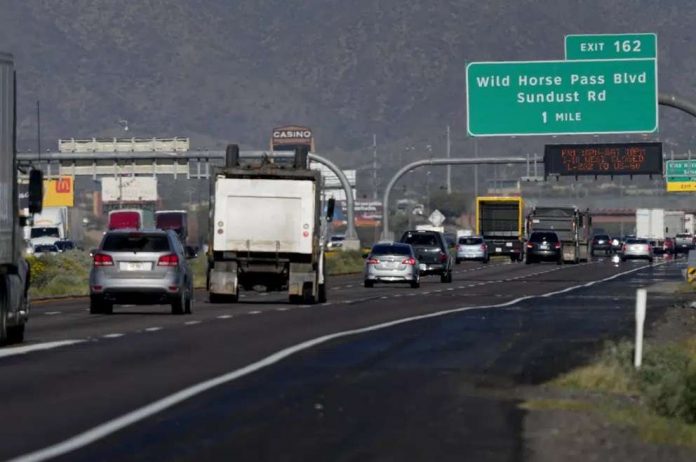By JEFF McMURRAY
Associated Press
Arizona officials refer to a notoriously congested stretch of desert highway through tribal land as the Wild Horse Pass Corridor, a label that’s less about horses than the bustling casino by the same name located just north of where the interstate constricts to four lanes.
With the Gila River Indian Community’s backing, the state allocated or raised about $600 million of a nearly $1 billion plan that would widen the most bottleneck-inducing, 26-mile section of I-10 on the route between Phoenix and Tucson.
But its bid for federal grant money under the new infrastructure law to finish the job fell short, leaving some advocates for road construction accusing the Biden administration of devaluing those projects to focus on repairs and mass transit.
“Upset would be the right terminology,” Casa Grande Mayor Craig McFarland said of his reaction when he learned the project won’t receive one of the law’s first Mega Grants the U.S. Department of Transportation will announce this week. “We thought we had done a good job putting the proposal together. We thought we had checked all the boxes.”
The historic federal investment in infrastructure has reenergized dormant transportation projects, but the debate over how to prioritize them has only intensified in the 14 months since President Joe Biden signed the measure.
The law follows decades of neglect in maintaining the nation’s roads, bridges, water systems and airports. Research by Yale University economist Ray Fair estimates a sharp decline in U.S. infrastructure investment has caused a $5.2 trillion shortfall. The entire law totals $1 trillion, and it seeks to not only remedy that dangerous backlog of projects but also build out broadband internet nationwide and protect against damage caused by climate change.
Some of the money, however, has gone to new highway construction — much of it from the nearly 30% increases Arizona and most other states are receiving over the next five years in the formula funding they can use to prioritize their own transportation needs.
For specific projects, many of the biggest awards available under the law are through various highly competitive grants. The Department of Transportation received around $30 billion worth of applications for just the first $1 billion in Mega Grants being awarded, spokesperson Dani Simons said.
Another $1 billion will be available each of the next four years before the funding runs out. Still, the first batch has been closely watched for signals about the administration’s preferences.
Jeff Davis, senior fellow at the Eno Center for Transportation, said it’s already clear that the Biden administration plans to direct a greater share of its discretionary transportation funding to “non-highway projects” than the Trump administration did. However, with so much more total infrastructure money to work with, Davis said, “a rising tide lifts all boats.”
For example, one of the projects that the administration told Congress it had chosen for a Mega Grant will widen Interstate 10 — but in Mississippi, not Arizona. Davis said the department likely preferred the Mississippi project due to its significantly lower price tag. This year’s Mega Grants combine three different award types into a single application, one of which caters specifically to rural and impoverished communities.
Some of the winning grants are for bridges, while others are for mass transit — including improvements to Chicago’s commuter train system and concrete casing for a rail tunnel in Midtown Manhattan.
Along with the nine projects selected, transportation department staff listed seven others as “highly recommended” — a distinction Davis said makes them clear front-runners to secure money next year. Arizona’s I-10 widening effort was part of a third group of 13 projects labeled as “recommended,” which Davis said could put them in contention for future funding unless they’re surpassed by even stronger applicants.
But such decisions remain largely subjective.




















